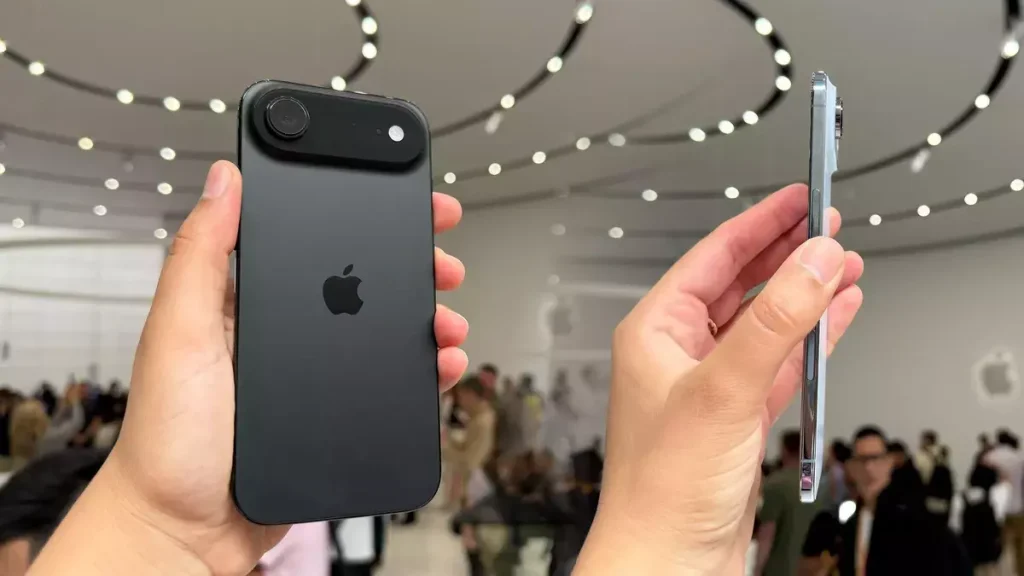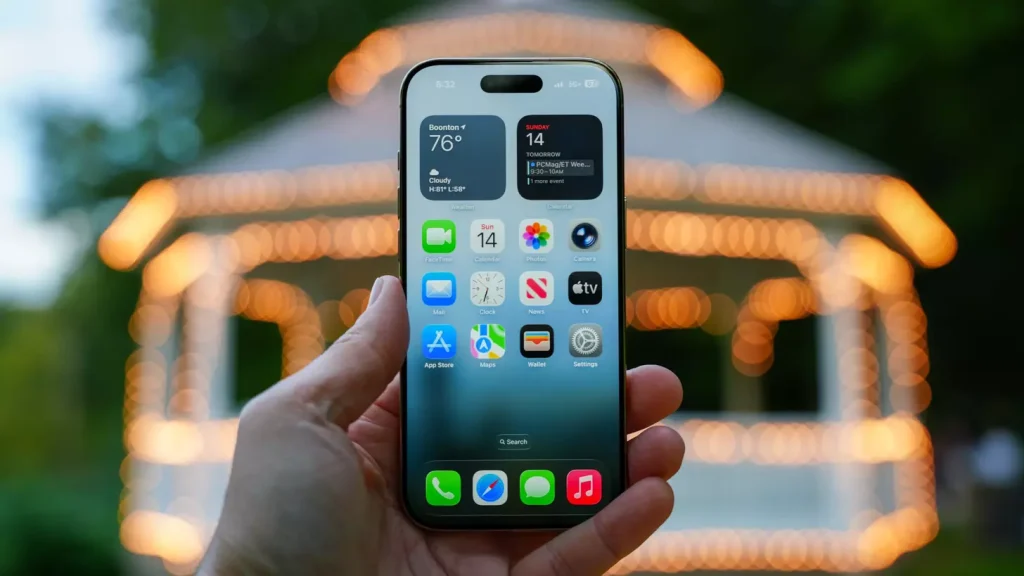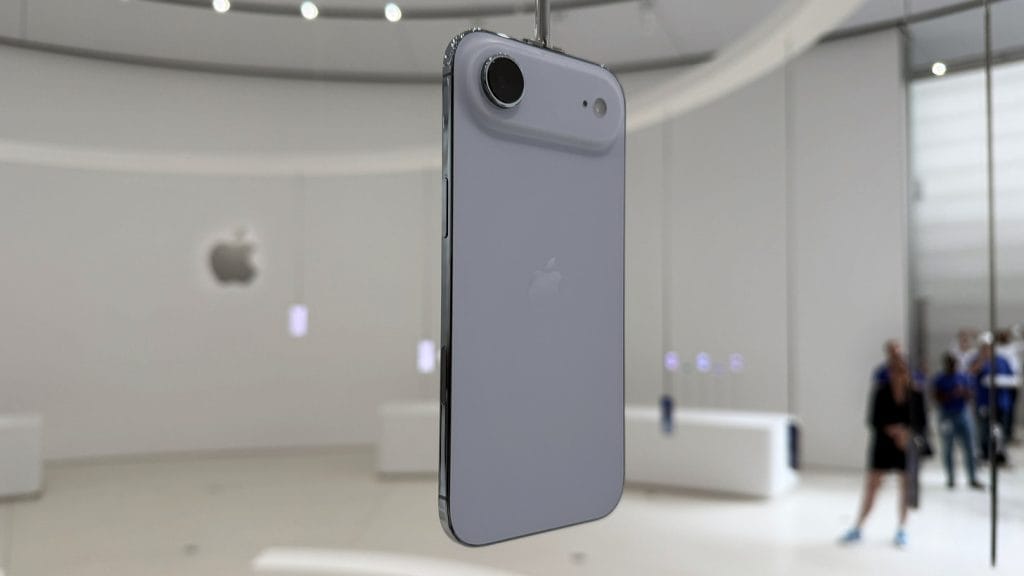I held the new iphone air and felt its remarkable balance of weight and strength. At just 5.6 mm thin and 165 g, this phone redefines what slim can be without feeling fragile.
The 6.5‑inch Super Retina XDR display with ProMotion at 120 Hz keeps every scroll and game smooth. Always‑On makes key info glanceable while a polished titanium frame and upgraded Ceramic Shield 2 protect the screen and back.
I noticed the A19 Pro chip delivers class‑leading cpu speed and an efficient GPU with per‑core Neural Accelerators. That performance keeps photos sharp, apps responsive and battery life sensible across a busy day.
Photographers and creators will like the 48 MP Fusion Main and 18 MP Centre Stage front camera for smarter selfies and Dual Capture video. Add modern connectivity and long video playback, and the experience suits anyone who wants a pro feel in a featherlight handset.
Key Takeaways
- The apple iphone air is ultra‑thin yet robust thanks to a titanium frame and Ceramic Shield 2.
- A vivid 6.5‑inch display with ProMotion and Always‑On enhances everyday use.
- A19 Pro chip gives top‑tier cpu and GPU performance while managing power well.
- Camera upgrades support high‑quality photos, next‑gen portraits and Dual Capture video.
- Strong battery life plus fast charging and optional MagSafe extension for longer time away from a charger.
Apple iPhone Air
I’m reviewing the Air because it launches alongside the iPhone 17 family at a £/€/$999 starting price for 256 GB and effectively replaces the old Plus tier. Over several days I tested whether the slim, 5.6 mm, 165 g build changes how people use a flagship phone in daily life.
My focus is practical: who benefits from a lighter handset and who should consider the Pro line instead. The Air pairs a polished titanium frame and Ceramic Shield 2 with a 6.5‑inch display and A19 Pro silicon that has one fewer GPU core than the 17 Pro.
Key questions I examine include battery life in real day‑to‑day use, whether a single 48 MP camera covers most photos, and how eSIM‑only and IP68 features suit travel and work. Below I list the tests I’ll cover in depth.
- Display comfort and outdoor visibility.
- Camera reliability and Centre Stage front performance.
- Battery life across one‑day and multi‑day scenarios, plus MagSafe extension.
- Comparisons of design and ergonomics with the Pro models.
By the end of this review you’ll know if the Air matches your priorities or if a Pro model still makes more sense for your time and photo demands.
Design and build: impossibly thin, reassuringly strong
At first glance the phone reads as featherlight; in my hand it proved tactically solid and well balanced.
5.6 mm, 165 g: how the thinness and weight feel in the hand
The apple iphone air measures 5.6 mm and weighs 165 g. That slim profile makes one‑hand use easy and reduces pocket bulk.
It feels noticeably light compared with many flagships, so I reached for it more often during the day. Grip is confident and fatigue was minimal.
Titanium frame, Ceramic Shield 2 front and back: durability that defies its silhouette
The polished Grade 5 titanium frame and Ceramic Shield 2 on the screen give a serious boost to perceived quality.
Front glass has three times better scratch resistance and the Ceramic Shield back claims four times better crack resistance. Bend tests past 130 pounds matched my hands‑on: no flex, no creaks.
Ergonomics, bumper case and camera plateau: daily usability observations
A raised rear camera plateau houses the 48 MP lens, the 18 MP front module and the chip. That engineering trade‑off saves depth but causes a small wobble on flat surfaces.
Apple’s slim Bumper case adds useful edge thickness without spoiling the light feel. 3D‑printed port components cut weight and still feel robust in daily use.
- Finish: glossy titanium resists torsion and stays cool.
- Colours: Space Black, Cloud White, Light Gold, Sky Blue suit the design.
- Practicality: strong build, pro feel, and subtle compromises for such a thin phone.
Display quality and visibility outdoors
Outdoor light is where a screen either shines or struggles, and this one leans clearly toward the former.
The 6.5‑inch Super Retina XDR panel delivers fluid motion with ProMotion at 120 Hz and a useful Always‑On mode. Scrolling, video playback and UI animations stay smooth and consistent thanks to the responsive touch pipeline driven by the a19 pro silicon.
Brightness, HDR peaks and anti‑reflection
Typical brightness sits around 1000 nits for everyday use, HDR peaks at 1600 nits and the panel can push to 3000 nits in direct sun. That peak outdoor output makes landscapes and bright skies readable without hunting for shade.
An improved anti‑reflective coating noticeably cuts glare, so photos and video remain clear when I’m framing shots on location. HDR content looks natural, with strong contrast and restrained colour saturation that helps creators judge exposure.
Practical notes on colour, text and feel
Text is crisp at normal viewing distances, which reduces eye strain during long reads. The calibrated screen holds colour well for landscape composition and playback, giving a dependable on‑device preview for photos and video.
- ProMotion 120 Hz keeps motion clean in UI and gaming.
- Always‑On lets me glance at widgets without waking the screen.
- Titanium chassis adds rigidity with no panel flex or colour shift.
- HDR peaks and anti‑reflective coating improve outdoor usability.
Performance and efficiency with A19 Pro

The A19 Pro transforms everyday tasks into near‑instant interactions, making the phone feel more capable than its slim frame suggests.
CPU/GPU gains and Neural Accelerators: real‑world speed
The chip uses a 6‑core CPU (two performance, four efficiency) and a 5‑core GPU, supported by 12 GB of RAM. That hardware plus a 16‑core Neural Engine and improved caching gives a clear responsiveness boost.
In real use apps open swiftly and multitasking stays smooth. Batch edits and video exports finish faster than older models, and the CPU claims of up to 40% faster feel plausible in daily work.
Per‑core Neural Accelerators on the GPU speed on‑device AI tasks like object clean‑up and smarter photo rendering without hammering battery life.
Gaming and sustained performance in a thin chassis
Even with one fewer GPU core than the 17 Pro, gaming runs happily at 120 Hz where supported. Frame rates remain stable over long sessions and animations stay fluid.
- Thermals are well managed; the slim chassis sheds heat and keeps the phone comfortable to hold.
- Exporting short 4K clips is quick while background tasks continue to run.
- Power draw in light tasks is modest, which helps battery life across a working day.
Overall, the A19 Pro in this model delivers flagship performance with sensible power behaviour. The system feels fast, efficient and ready for heavy photo and video work without obvious compromises.
Battery life and charging experience
Real‑world use — from commuting to shoots — shows how dependable the power system really is. The phone is built to squeeze usable cell volume into a slim frame and that design pays off in daily stamina.
All‑day claims: up to 27 hours video playback in practice
Rated for up to 27 hours of video playback and 22 hours of streaming, the handset often approaches those figures in mixed use. Lighter days reliably last from morning until night on a single charge.
Streaming and heavy camera use reduce runtime faster, but the drop is predictable and the device cools quickly once activity eases.
Fast charge and wireless limits
Wired fast charging reaches about 50% in 30 minutes with a 20 W or stronger adapter. That quick morning boost is handy for busy days.
Wireless charging via Qi2 or MagSafe is capped at 20 W, a small step down from the 25 W some pro models support. In practice, lunchtime top‑ups still add meaningful range.
Extending runtime with the MagSafe accessory
The Air MagSafe Battery accessory snaps on cleanly and lifts total video playback toward 40 hours. It charges quickly when the phone runs low, then shifts to smart maintenance if left attached all day.
- Mixed use tends to match the 27‑hour playback claim.
- Streaming endurance aligns with the quoted 22 hours.
- Wired 50% in 30 minutes is dependable; wireless is limited to 20 W.
- The magsafe battery adds around 13 hours of extra playback in my tests.
Camera system: fewer lenses, smarter shots
This model chooses a single, versatile rear sensor and relies on smarts to get the shot right. The approach simplifies choices while preserving flexibility for everyday photography and creators on the move.
48 MP Fusion Main with 1x/2x and next‑gen portraits
The 48 MP Fusion Main delivers crisp detail at native 1x and a clean 2x crop. Preset 28 mm and 35 mm framings let me switch storytelling styles fast.
Next‑generation portrait tools capture depth automatically. Focus Control lets me shift emphasis after I shoot, which is handy for spontaneous portraits.
18 MP Centre Stage front camera: smarter group selfies
The 18 MP Centre Stage front camera widens to fit more people. It also reframes between portrait and landscape without me rotating the phone, and stabilises framing during calls.
Dual Capture and video performance
Dual Capture records front and rear cameras together, ideal for vlogs or event recaps. 4K 60 fps Dolby Vision footage looks polished straight from the handset, and stabilisation keeps walking clips usable without extra kit.
- Low‑light processing improves colour and reduces motion smear.
- Skin tones stay natural; default processing avoids over‑sharpening.
- Extended filming impacts battery, so I use a MagSafe pack for long takes.
Software and intelligence features that make a difference
On-device intelligence now does the heavy lifting, keeping edits and suggestions local and fast.
Local AI tools and quick edits
I used Clean Up and other intelligence tools to remove distractions from photos without sending data to a server. The A19 Pro’s Neural Accelerators make the process feel instant.
Physical controls and visual hints
The Action button is customisable and gives tactile certainty for repeated tasks.
The Camera Control button opens the app instantly and surfaces Visual Intelligence tips for better framing in both portrait and landscape modes.
“I appreciated features that speed routine tasks and keep the UI uncluttered.”
- Centre Stage keeps me centred on video calls as people move in and out of frame.
- Dual Capture records reactions and scene together, which speeds up vlogging workflows.
- Video tools and smart adjustments run smoothly and have minimal battery impact.
The overall system stays clean and usable, so these features enhance my phone experience without a steep learning curve.
Connectivity, SIM and resilience

When I tested network hand‑offs and local transfers, the radio performance stood out for its stability. The C1X modem proved twice as fast as its predecessor on sub‑6 GHz 5G, giving reliable speeds without mmWave complications.
The N1 networking chip brought Wi‑Fi 7, Bluetooth 6 and Thread to daily use. Large file transfers finished quickly and accessories kept a steady link while I moved between rooms.
C1X, N1 and everyday use
The system handled crowded venues with assured signal swaps, and dual‑frequency GPS locked on fast in built‑up areas. Power draw stayed modest, which helped battery life across long shoots and commutes.
eSIM, durability and safety
It is eSIM‑only worldwide, so setup in the UK was quick, though travellers should check carrier support before a trip. IP68 water and dust resistance gives me confidence at the beach and on rainy mornings without a heavy‑duty case.
“I relied on Emergency SOS and Messages via satellite during an off‑grid test; the safety features feel like a proper back‑up.”
- Fast, stable sub‑6 GHz 5G and no mmWave trade‑offs.
- Wi‑Fi 7 transfers and Thread improve smart‑home speed.
- Robust frame and seals match the thin design for long‑term resilience.
How it compares and who should buy it
Deciding between models comes down to the trade‑offs you value most: portability versus lens range and the very longest runtimes.
I found the apple iphone air shares the headline tech that matters — ProMotion at 120 Hz, Always‑On display and on‑device intelligence — while trimming a few pro features to save weight.
iPhone 17 and 17 Pro alternatives: my pick for different buyers
If you want the lightest big‑screen phone with a flagship feel, the iphone air is my pick. Performance from the a19 pro chip and CPU responsiveness feel near‑Pro in daily use.
- Choose 17 Pro if you need multiple lenses and the longest video hours; it’s heavier but more versatile for niche shooting.
- Pick the standard 17 for a middle ground: slightly smaller display, 25 W wireless and solid camera flexibility.
- For commuters and travellers who value comfort, the reduced weight and ergonomics of the Air make a real difference.
- Creators who capture video often will like the Air’s Dual Capture and 4K 60 fps, but opt for Pro if you need extra optical range.
The Air tops out at 27 hours of video playback and offers 20 W Qi2/MagSafe wireless charging, though the magsafe battery solves long shoots neatly. Storage starts at 256 GB with larger tiers available, which is sensible for most users.
Conclusion
I spent time with the apple iphone air and came away impressed. The 5.6 mm titanium design, ProMotion display and A19 Pro responsiveness deliver a rare blend of comfort and power.
Day to day the phone feels effortless to use. The single 48 MP camera, 18 MP Centre Stage front, Dual Capture and 4K 60 fps video produce photos and video that satisfy most creators without fuss.
Battery life outpaced my expectations; a quick top‑up or the MagSafe pack keeps me going through long shoots and travel. eSIM‑only setup, IP68 and modern connectivity round out a package built for real life.
If you prize comfort, speed and simplicity, the iphone air is the most enjoyable daily iPhone I’ve used in years. Choose a Pro model only if you need extra optical reach or the very longest runtimes.


great site. hope to see more
Greatest light weight camera ever. Features only usually seen on top end SRLs